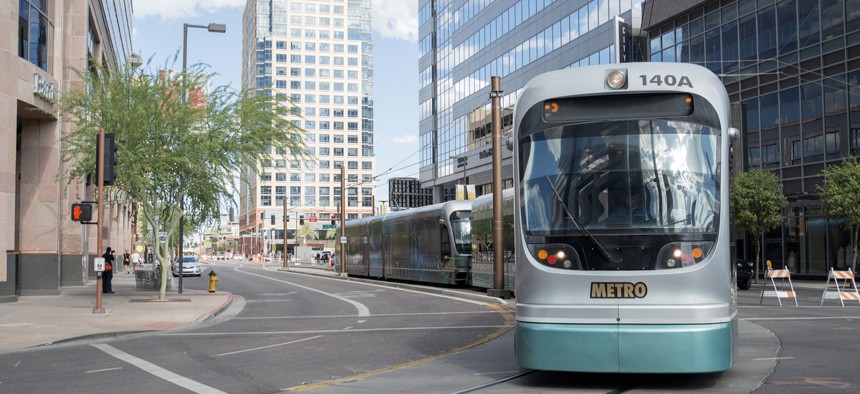Using Data to Figure Out Where Transit Should Go

Phoenix Metro Light Rail train goes through downtown. tishomir/Shutterstock.com
Fixed-route bus use, in particular, has seen steep declines in use while ride-sharing continues to grow in popularity, according to a new report.
Transit agencies must make better use of nontraditional data on consumer activity to combat declining ridership and effectively partner with the private sector to expand their transportation networks, according to a new KPMG report.
This means drilling down into information like cell phone data to figure out where people need to go and where they are starting out their trips. Ted Hamer, managing director of KPMG’s infrastructure practice, said tapping into this kind of broader information can help with rethinking mobility.
So, if planners with a transit agency knows where people are generally going when they leave the Dallas/Fort Worth International Airport, they can specialize service to fulfill a need, he said.
Overall transit ridership dropped 5 percent in the last decade, fueled by reduced bus use, the professional services company reports.
Heavy rail, subway, commuter rail, and light rail use remains consistent if not increasing in major cities like Dallas because it avoids congestion and that’s attractive to riders, Hamer said. But fixed-route bus schedules timed for peak periods have led to widespread abandonment of transit even in cities like Denver, Houston and San Diego.
“That doesn’t often fit with the demographic of people who need transit to get to work,” Hamer told Route Fifty.
“Accelerating Mobility” lays out a number of reasons for this including riders waiting 150 hours a year for transit, the $90 billion backlog in unfunded U.S. infrastructure projects to maintain bus and rail systems, and the expected growth of the sharing economy to $400 billion by 2025.
The convenience of ride-sharing as an alternative isn’t solely to blame because favorable interest rates and historically low gas prices have made car ownership easier, Hamer said. While this is true, the Federal Reserve Bank of New York also recently reported that a record number of people are three months behind on their car loans, which experts have called a troubling economic indicator.
Among U.S. commuters 85 percent do so by car, and 90 percent of them do so alone, according to the report.
Unless they adapt to customer needs, transit agencies will miss opportunities to partner with global companies developing transportation networks, private technology companies like Waze and Google Maps, and ride-hailing companies like Uber and Lyft.
“Five years ago—certainly 10 years ago—there were three or four major ways to get around the city,” Hamer said. “Today there’s more like 13 or 14.”
Car-sharing services like car2go and GM’s Maven, scooter services like Lime and Bird, and bike sharing have been added to the mix in recent years to where bus use is down 20 percent in Chicago and 15 percent in New York City. Only in cities like Columbus, Ohio, where the transit agency has rethought service, is bus use up, Hamer said.
The private sector is ready and willing to partner on first-mile, last-mile projects connecting riders to transit and funneling them into high-frequency corridors, Hamer said. Arlington, Texas and Cincinnati partnered with Uber pool to do just that.
“With the shifting landscape of technological transformation, these partnerships are going to be important to the public sector,” Hamer said. “We don’t think any of this is mutually exclusive.”
The ability to get from point A to point B “cheaply and consistently” leads to greater economic success and equity, Hamer said.
In Columbus, the Central Ohio Transit Authority developed a five-year strategic plan that requires consumer data be understood before a major project is undertaken. The end result is that the city is slowly enabling consumers unlimited choice in how they get around through carefully entered partnerships, Hamer said.
“Use competition to bring out the best in everybody,” he said.
NEXT STORY: FCW Insider: Feb. 21



